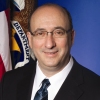
Michaels Outlines Big Agenda, Cooperative Plans
DENVER -- Sharing an agenda that includes devising a better method for promulgating standards -- a challenge several predecessors were unable to answer -- David Michaels, Ph.D., MPH, the OSHA assistant secretary, shared a stage Wednesday morning with Dr. John Howard, director of NIOSH, and discussed their agencies' programs and cooperative efforts. Michaels began by saying he hopes to accomplish better targeting of OSHA's enforcement within three years, as well as having an injury and illness prevention program (I2P2) standard in place and to have encouraged U.S. employers to embrace electronic recordkeeping of injuries and illnesses.
The I2P2 standard can transform the way American businesses address safety and health, and electronic recordkeeping will help businesses use their own data to make their workplaces safer, Michaels said.
"I think our relationship at a personal level couldn't be better," Howard said of Michaels, noting he has worked with nine assistant secretaries during his 11 years as head of Cal/OSHA and two tenures as NIOSH director. Cal/OSHA enacted an injury and illness prevention program standard in 1991, and about 18 states have similar standards in place, so OSHA will not have to start from scratch on its own standard, Howard said.
As he has before, Michaels said he wants to stop using injury and illness rates as the chief benchmark for measuring OSHA's success because the data aren't accurate, he said. "They don't measure something that we think is very important, which is the likelihood of severe injury occurring. Injury and illness rates are really not predictive."
He mentioned three upcoming stakeholder meetings about I2P2 and asked the assembled industrial hygienists to participate and share their companies' knowledge and experience. "We hope you can participate in this process -- and bring your employers along with you," he said.
Michaels said OSHA is trying to learn how to use the work NIOSH does more creatively and effectively. Bisphenol A is an example, he said, citing a NIOSH study of workers in China that indicated the chemical is linked to reproductive health effects. OSHA won't issue a standard about it because few workers are exposed and many, but not all, are working in controlled settings, Michaels said. The question is, he said, what should OSHA do about the chemical, being armed with the study NIOSH performed?
The two men said they are interested in co-branding documents and work product jointly with the names of NIOSH and OSHA. Both said it is important for workers to be more involved in safety and health programs, and both said they support the Protecting America's Workers Act now before Congress.
Many OSHA materials now are written for OSH professionals, who don't need them, said Michaels. He said OSHA is trying now to rewrite some of them for workers and small businesses.
Michaels also expressed interest in something he called "OSHApedia," a resource offering the shared knowledge of OSHA staffers about safety and health topics, a la Wikipedia. He said the U.S. intelligence services are doing something like it internally. Likewise, Michaels said, OSHApedia would be internal at the start and later shared with the world.
Howard said he he supports a federal clearinghouse for risk assessments performed by agencies including NIOSH and EPA. Such a clearinghouse could help OSHA accomplish the much-needed update of its permissible exposure limits, he added.